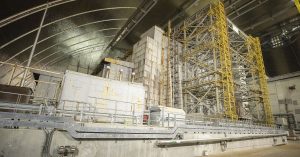Let’s just stop to think for a minute how incredible science is. Without science, there would be no treatments for cancer, knowledge about our ancestors, or the modern-day technology that we use today. In addition, we would be more likely to get sick, and the mortality rate would be higher. Imagine a world without computers, proper nutrition, big-scale farming, electricity, factories that mass-produce the clothing we wear on a daily basis, or even vehicles to drive. It’s scary to think where we would without science be versus where we are now with science!
But even today, there’s more for scientists to learn and discover. In 1991, five years after a nuclear accident occurred at the Chernobyl Nuclear Power Plant in Ukraine, mysterious black fungi were found growing inside the plant’s gamma-filled No. 4 nuclear reactor. The researchers found that the fungi were breaking down radioactive graphite and, not to mention, were growing towards radiation sources.
Then in 2007, research was released by Ekaterina Dadachova and her colleagues at the Albert Einstein College of Medicine in New York regarding other related findings. For one, they discovered that fungi tend to grow faster when near radiation. Secondly, three species of fungi that the team tested contained substantial levels of melanin. As many know, melanin is also found in the human skin. The darker one’s skin, the greater melanin their skill cells contain. (No wonder the fungi in the discovery was so dark in color, because they contained large amounts of melanin!)
Normally, melanin is known for absorbing light and reducing the penetration of ultraviolet radiation through the epidermis layer of the skin. However, in the case of the radiation-feeding fungi, their absorption of radiation that they then convert to chemical energy for their own growth is similar to the process of photosynthesis (or in this case, radiosynthesis).
So, what does all of this mean? Well, since 2016, researchers have been attempting to see if radiation-consuming fungi could produce molecules that could be used in a special medicine that astronauts could take to protect themselves from the high levels of radiation in space during lengthy missions. Or, perhaps the astronauts could even grow the fungi during their flights. Interesting!
Based on the findings, some may speculate that the melanin of our skin cells could be used to turn radiation into food. Unfortunately, that doesn’t seem to be the case. Dadachova’s colleague, Arturo Casadevall, states, “Currently there is no evidence for this. However the fact that it occurs in fungi raises the possibility that the same may occur in animals and plants.”
Although there are some missing puzzle pieces and misconceptions, the research thus far has raised some interesting questions and hypotheses! Hopefully there will soon be more intriguing discoveries and confirmations based on this research.
Watch the following video if you’re interested in learning more about radiotrophic (radiation-eating) fungus.









